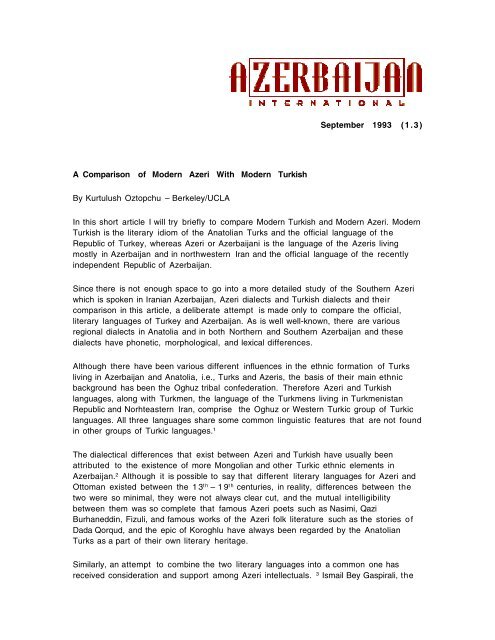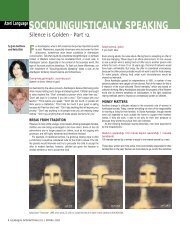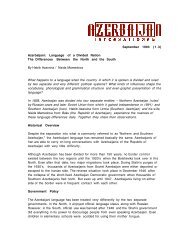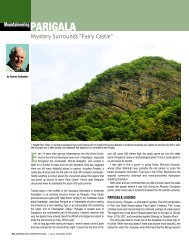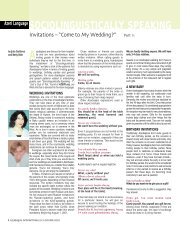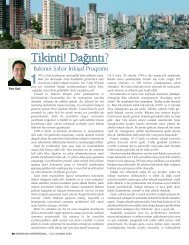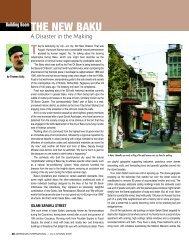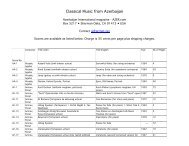(1.3) A Comparison of Modern Azeri With Modern Turkish
(1.3) A Comparison of Modern Azeri With Modern Turkish
(1.3) A Comparison of Modern Azeri With Modern Turkish
You also want an ePaper? Increase the reach of your titles
YUMPU automatically turns print PDFs into web optimized ePapers that Google loves.
A <strong>Comparison</strong> <strong>of</strong> <strong>Modern</strong> <strong>Azeri</strong> <strong>With</strong> <strong>Modern</strong> <strong>Turkish</strong><br />
By Kurtulush Oztopchu – Berkeley/UCLA<br />
September 1993 (<strong>1.3</strong>)<br />
In this short article I will try briefly to compare <strong>Modern</strong> <strong>Turkish</strong> and <strong>Modern</strong> <strong>Azeri</strong>. <strong>Modern</strong><br />
<strong>Turkish</strong> is the literary idiom <strong>of</strong> the Anatolian Turks and the <strong>of</strong>ficial language <strong>of</strong> the<br />
Republic <strong>of</strong> Turkey, whereas <strong>Azeri</strong> or Azerbaijani is the language <strong>of</strong> the <strong>Azeri</strong>s living<br />
mostly in Azerbaijan and in northwestern Iran and the <strong>of</strong>ficial language <strong>of</strong> the recently<br />
independent Republic <strong>of</strong> Azerbaijan.<br />
Since there is not enough space to go into a more detailed study <strong>of</strong> the Southern <strong>Azeri</strong><br />
which is spoken in Iranian Azerbaijan, <strong>Azeri</strong> dialects and <strong>Turkish</strong> dialects and their<br />
comparison in this article, a deliberate attempt is made only to compare the <strong>of</strong>ficial,<br />
literary languages <strong>of</strong> Turkey and Azerbaijan. As is well well-known, there are various<br />
regional dialects in Anatolia and in both Northern and Southern Azerbaijan and these<br />
dialects have phonetic, morphological, and lexical differences.<br />
Although there have been various different influences in the ethnic formation <strong>of</strong> Turks<br />
living in Azerbaijan and Anatolia, i.e., Turks and <strong>Azeri</strong>s, the basis <strong>of</strong> their main ethnic<br />
background has been the Oghuz tribal confederation. Therefore <strong>Azeri</strong> and <strong>Turkish</strong><br />
languages, along with Turkmen, the language <strong>of</strong> the Turkmens living in Turkmenistan<br />
Republic and Norhteastern Iran, comprise the Oghuz or Western Turkic group <strong>of</strong> Turkic<br />
languages. All three languages share some common linguistic features that are not found<br />
in other groups <strong>of</strong> Turkic languages. 1<br />
The dialectical differences that exist between <strong>Azeri</strong> and <strong>Turkish</strong> have usually been<br />
attributed to the existence <strong>of</strong> more Mongolian and other Turkic ethnic elements in<br />
Azerbaijan. 2 Although it is possible to say that different literary languages for <strong>Azeri</strong> and<br />
Ottoman existed between the 1 3 th – 1 9 th centuries, in reality, differences between the<br />
two were so minimal, they were not always clear cut, and the mutual intelligibility<br />
between them was so complete that famous <strong>Azeri</strong> poets such as Nasimi, Qazi<br />
Burhaneddin, Fizuli, and famous works <strong>of</strong> the <strong>Azeri</strong> folk literature such as the stories <strong>of</strong><br />
Dada Qorqud, and the epic <strong>of</strong> Koroghlu have always been regarded by the Anatolian<br />
Turks as a part <strong>of</strong> their own literary heritage.<br />
Similarly, an attempt to combine the two literary languages into a common one has<br />
received consideration and support among <strong>Azeri</strong> intellectuals. 3 Ismail Bey Gaspirali, the
leading intellectual <strong>of</strong> the Grimean Tatars in the 1 9th century, went a step further, and<br />
suggested a common literary language for all the Turks living in the Middle East, Central<br />
Asia and various regions <strong>of</strong> Russia. 4<br />
Differences between <strong>Turkish</strong> and Azerbaijani increased in some areas in the twentieth<br />
century as a result <strong>of</strong> the two languages undergoing different developments and<br />
changes, and receiving different foreign influences during these processes.<br />
A brief comparison <strong>of</strong> some <strong>of</strong> the most prominent features <strong>of</strong> <strong>Azeri</strong> and <strong>Turkish</strong> follows.<br />
Since some well-known general linguistic features <strong>of</strong> the Turkic languages such as<br />
agglutination, inflection <strong>of</strong> nouns for case, formation <strong>of</strong> passive, causative, reflexive,<br />
reciprocal, and negative verbal structures by suffixes, using postpositions instead <strong>of</strong><br />
prepositions, having a subject-object-verb word order, modifiers preceding the modified<br />
head nouns, and absence <strong>of</strong> gender, definite article, duality, certain initial and final<br />
consonant clusters, are shared by both languages, I did not elaborate on these features<br />
separately in this comparison. And since there are many more similarities between the<br />
two languages, dissimilarities rather than the similarities are stressed below.<br />
a) Orthography and Phonology<br />
For <strong>Modern</strong> <strong>Turkish</strong> a modified Latin alphabet has been in use since 1928. Prior to that,<br />
it was written in an Arabic script. For <strong>Azeri</strong>, also an Arabic script was used until 1928.<br />
In 1928 a modified Latin script, although different than that <strong>of</strong> <strong>Turkish</strong>, began to be<br />
used. It was replaced by a modified Cyrillic alphabet in 1940 which with a few<br />
modifications was in use until 1991. 5<br />
After the independence <strong>of</strong> Azerbaijan, a Latin alphabet, based on the <strong>Turkish</strong> model,<br />
replaced the Cyrillic script. There are 29 characters in the <strong>Turkish</strong> alphabet. In the <strong>Azeri</strong><br />
alphabet, in addition to these 29, there are 3 more characters: 6<br />
q /x, g, ,k/<br />
x /x/<br />
w /ä/<br />
Vowel Changes:<br />
In some words:<br />
<strong>Turkish</strong> -u- changes to <strong>Azeri</strong> -o-:<br />
English<br />
lip<br />
to wake up<br />
<strong>Turkish</strong> -^- changes to <strong>Azeri</strong> -=-<br />
<strong>Turkish</strong><br />
dudak<br />
uyan-<br />
<strong>Azeri</strong><br />
dodaq/dodax<br />
oyan-
ig<br />
beautiful<br />
b^y^k<br />
g^zel<br />
Labialization before -v- in some words:<br />
rabbit<br />
hunter<br />
<strong>Turkish</strong> -^- changes to <strong>Azeri</strong> -i-<br />
tav]an<br />
avc\<br />
b=y^k<br />
g=zwl<br />
dov]an<br />
ov[u<br />
small k^[^k ki[ik<br />
Many <strong>of</strong> the Arabic and Persina oan words in <strong>Azeri</strong> have the variants containing the<br />
front vowels as opposed to the <strong>Turkish</strong> ones that contain the back vowels:<br />
heart<br />
teacher<br />
kalb<br />
muallim<br />
qwlb/gwlb<br />
m^wllim<br />
Word initial <strong>Turkish</strong> \- does not exist in <strong>Azeri</strong>. It usually becomes an i- :<br />
light<br />
to get warm<br />
\]\k<br />
\s\n<br />
i]\q/i]\x<br />
isin-<br />
Consonant changes: Although there are some exceptions in both <strong>Azeri</strong> and <strong>Turkish</strong>,<br />
voicing <strong>of</strong> such consonants as Old Tukic “t” and “k” in the word-initial position, which is a<br />
common features <strong>of</strong> Oghuz group <strong>of</strong> languages, is common in both languages:<br />
<strong>Azeri</strong>, like some <strong>of</strong> the Anatolian dialects, takes this process one step further and applies<br />
it on Old Turkic word-initial q (/g/ in A.) sound as well: A. qal - /gal/ to stay, remain, is<br />
kal - /kal-/ in <strong>Turkish</strong> but gal- in some Anatolian dialects, qal- in Bashkir, Uygur, Kazakh,<br />
etc., A. q\l\nc /g\l\c / sword, is k\l\[ in <strong>Turkish</strong>, but g\l\[ in some Anatolian dialects, q\l\s<br />
in Bashkir, q\l\[ in Kirgiz and Uyghur, and q\l\] in Kazakh.<br />
Consonant <strong>Comparison</strong>s<br />
English <strong>Turkish</strong> <strong>Azeri</strong> Uzbek Kazakh Tatar Kirghiz Uyghur<br />
tongue/language<br />
to freeze<br />
eye<br />
to laugh<br />
dil 7<br />
dong=zg^l-<br />
dildong=z<br />
g^l<br />
til<br />
tongk^zk^l-<br />
tiltongk^zk^l-<br />
tiltungk^z<br />
k=l<br />
til<br />
tongk=zk^l-<br />
tiltongk=zk^l-
Some <strong>of</strong> the most distinguishing phonetic features <strong>of</strong> <strong>Azeri</strong> are also common features <strong>of</strong><br />
many Anatolian dialects, most notably Central Anatolian dialects, such as Eskishehir,<br />
Ankara, and Konya. 8 For example:<br />
The –k- > -x- > and –k- > -x change:<br />
English<br />
back<br />
to read<br />
many, much<br />
foot<br />
<strong>Turkish</strong><br />
arka<br />
oku-<br />
[ok<br />
ayak<br />
<strong>Azeri</strong><br />
arxa<br />
oxu-<br />
[ox<br />
ayaq/ayax<br />
Word final –p, -[, -t, -k voiceless consonants in many <strong>Turkish</strong> words change to –b, -c, -d,<br />
and -g respectively in <strong>Azeri</strong>:<br />
English<br />
hungry<br />
milk<br />
color<br />
book<br />
b) Morphology:<br />
<strong>Turkish</strong><br />
a[<br />
s^t<br />
renk<br />
kitap<br />
<strong>Azeri</strong><br />
ac<br />
s^d<br />
rwng<br />
kitab<br />
Noun: Plural suffixes are the same in both languages. Among the case endings, dative<br />
and genitive are the same, for locative and ablative A. uses only the versions that have<br />
voiced consonants, i.e. –da, -dw, and dan, -dwn,<br />
<strong>Turkish</strong> also uses the versions with voiceless counterparts <strong>of</strong> the same suffixes, i. e. –ta,<br />
-te, and –tan, -ten: A. universitetdw ‘at the university,’ universitetdwn ‘from the<br />
university’; T. mektepte ‘at the school,’ mektepten ‘from the school.’ In the objective<br />
case, A. has -n\, -ni, -nu, -n^, whereas T. has -y\, yi, -yu, -y^ after words that end in<br />
vowel: A. dairwni ‘the cirle,’ T. daireyi. However, in the word su ‘water’ A. also uses the<br />
yu suffix in the objective case. Possessive suffixes are the same. The genitivepossessive<br />
structure ‘izafet’ is the same.<br />
Derivational suffixes are particularly identical in both languages, the only difference<br />
is that A. prefers mostly the voiced consonants with some suffixes and T. has both<br />
voiced and voiceless versions.<br />
Personal suffixes used with the verb ‘to be’ in the present tense are slightly different<br />
in some persons. For the singular first person A. has
-(y)am, -(y)wm; T. has -(y)\m, -(y)im, -(y)^m; for the second person A. has -san, swn; T.<br />
has –s\n, -sin, -sun, -s^n. For the plural first person A. has -(y)\q, -(y)ik, -(y)uq, -(y)^k,<br />
and T. has -(y)\z, -(y)iz, -(y)uz, -(y)^z.<br />
Suffixes for other persons are the same. The past and conditional forms <strong>of</strong> the verb ‘to<br />
be’ are also the same in both languages: A. twlwbwywm ‘I am a student’, T. talebeyim, A.<br />
twlwbwyik ‘we are students,’ talebeyiz; A. twlwbw idi ‘(s)he’ was a student, T. talebe idi.<br />
Personal pronouns are the same with the exception <strong>of</strong> ‘I.’ In A. it is mwn, in T. ben.<br />
Its declension is also different; in A. mwnim, mwni, mwnw, mwndw, mwndwn, in T. benim,<br />
beni, bana, bende, benden. Reflexive pronoun in A. is =z ‘myself’, whereas in T. it is<br />
kendi.<br />
Demonstrative pronouns are the same. T. ]u is not used in A., instead hwmin is<br />
used. Some interrogative pronouns are different, and some are the same: Here are some<br />
<strong>of</strong> the different ones:<br />
Interrogative Pronouns<br />
English <strong>Turkish</strong> <strong>Azeri</strong><br />
which hangi hans\<br />
all hepsi ham\s\<br />
nobody hi[ kimsw he[ kws<br />
nobody hi[ kimsw he[ kim<br />
nothing hi[bir ]ey he[ nw<br />
where nerede harada<br />
when ne zaman ha[an<br />
how nas\l necw<br />
Adjectives: Comparative and superlative degrees <strong>of</strong> adjectives, diminutives,<br />
intensifiers are basically the same: daha g=zwl ‘more beautiful,’ wn g=zwl ‘the most<br />
beautiful,’ bombo], ‘completely empty.’ Numerals are basically the same.<br />
The following are the slightly different ones: A. d=rd ‘four’, yeddi ‘seven’, swggiz ‘eight,’<br />
doqquz ‘nine’, iyirmi ‘twenty,’ min ‘thousand,’ milyard ‘billion’ = T. d=rt, yedi, sekiz,<br />
dokuz, yirmi, bin, milyar. Ordinal numbers are obtained in the same way.<br />
Postpositions: Most <strong>of</strong> the postpositions are the same in both languages. Some <strong>Azeri</strong><br />
postpositions such as twkin ‘like,’ twk ‘like’, kimi ‘like,’ sar\ ‘towards,’ -can ‘until’ are not<br />
used in <strong>Turkish</strong>.<br />
Verbs: The personal suffixes that are used in the formation <strong>of</strong> reported past tense,<br />
present tense, future tense, aoristfuture tense, necessitative are slightly different in
some persons. First peron singular usually takes the suffixes –am, wm, second person<br />
singular takes –swn, swn, and first person plural takes -\q, ik, -uq, -^k for T. -(y\m),-<br />
(y)im, -(y)um, -(y)^m; -s\n, -sin, -sun, -s^n; -(y)\z, -(y)iz, -(y)^z respectively; A.<br />
gwlmwliywm ‘I must come,’ T. gelmeliyim; A. gwlirswn ‘you are coming,’ T.gelirsin ‘you<br />
come.’<br />
Definite past tense reported paste tense, future tense, conditional, necessitative are<br />
declined in the same way in both A. and T. by using the same suffixes barring the<br />
differences for personal endings noted above.<br />
Aorist: <strong>Turkish</strong> aorist is declined in the same way in A., but it also indicates an<br />
indefinite future function. In A. for the present continuous tense -(y)\r, -(y)ir, -(y)ur, -<br />
(y)^r suffixes are used, in T. -(i)yor is used: A. gwlirwm ‘I am coming,’= T. geliyorum. A<br />
reported past tense that is used in <strong>Azeri</strong> is not used in T.; gwlibswn ‘you have come, you<br />
reportedly came,’ oxuyub ‘(s)he has read, (s)he reportedly read.’<br />
Necessity: In A. there are two more ways <strong>of</strong> expressing necessity. T. does not have<br />
these forms: gwlwsiywm ‘I have to come,’ gwlwsiswn, gwlwsidir, etc., and gwrwk gwlwm, ‘I<br />
need to come,’ gwrwk gwlwswn, gwrwk gwlw, etc.Negation <strong>of</strong> verbal forms are obtained by -<br />
ma, -mw suffixes in both languages, however in A. in the present continuous and aoristfuture<br />
tensesit is only –m: al\ram ‘I take,’ alm\ram ‘I don’t take,’ al\ram ‘I am taking,’<br />
alm\ram ‘I am not taking.’ Imperative is the same in all persons except in the first person<br />
singular and plural: A. gwlim ‘Let me come,’ T. geleyim, A. oxuyaq ‘let us read,’ T.<br />
okuyal\m.<br />
Ability is the same in affirmative form, but different in the negative: A. gwlw bildim ‘I was<br />
able to come,’ T. gelebildim; but A. gwlw bilmwdim ‘I was not able to come,’ T.<br />
gelemedim. Question suffixes –m\, -mi, -mu, -m^ in verbal forms come almost always at<br />
the end in <strong>Azeri</strong>, in <strong>Turkish</strong> in many cases their places are more flexible.<br />
Participles: Most <strong>of</strong> the participial forms are the same. In A. the following participles<br />
are also used extensively: -as\, -wsi; and –mal\, -mwli: hwlledilwsi i] ‘the matter that will<br />
be solved,’ oxunmal\ kitab ‘the book that has to be read,’<br />
Gerunds: Both languages share a group <strong>of</strong> gerunds. A typical A. gerund is found in<br />
–anda, -wndw: gwlwndw ‘when coming, upon coming,’ oxuyanda ‘when reading, upon<br />
reading,’<br />
Reciprocal, passive, causative, and reflexive forms are basically the same, showing<br />
occasional sound changes. 9
c) Vocabulary:<br />
The overwhelming majority <strong>of</strong> the word stock is common to both languages. The main<br />
bulk <strong>of</strong> the Azerbaijani vocabulary is <strong>of</strong> Turkic origin. It represents typical Oghuz group<br />
features. However, in addition <strong>Azeri</strong> has also some words that are either not found in<br />
<strong>Turkish</strong> or they have different meanings. I am giving a random list here: dan\]- ‘to talk,’<br />
tap- ‘to find,’ arvad ‘wife,’ bulaq ‘spring, water source,’ bay\r ‘outside,’ kwnd ‘village,’<br />
qabaq ‘front,’ ya`\] ‘rain,’ subay ‘unmarried,’ d^]- ‘to get <strong>of</strong>f,’ qurtar- ‘to finish,’ apar-<br />
‘to take away,’ sabah ‘tomorrow,’ i]lwt- ‘to use,’ lap ‘very, extremely,’ n=kwr ‘friend.’<br />
Loan Words: Both languages share a large number <strong>of</strong> loanwords from Arabic and<br />
Persian. Most <strong>of</strong> them are used with the same or similar meanings, but are slightly<br />
different in pronunciation.<br />
Azerbaijani has many loanwords from Russian and in many cases they are also loanwords<br />
from other European languages. They are mostly related to technics, science and recent<br />
inventions, and represent a modern, changing lifestyle.<br />
On the other hand, T. borrowed this type <strong>of</strong> loanwords mostly from French, English,<br />
Italian and Greek. They might be similar, but in many cases different, indicating the<br />
source <strong>of</strong> this type <strong>of</strong> vocabulary: A. televizor ‘television set,’ T. televizyon; filtr ‘filter,’<br />
T. filitre; A. qwzet ‘newspaper,’ T. gazette; A. abunw ‘subscription,’ T. abone.<br />
d) Syntax:<br />
Sentence structure in the Turkic languages has a subject + object + verb word order. So<br />
both languages have the same type <strong>of</strong> word order, and in most cases they adhere to this<br />
structure. Both languages have many participles and gerunds, which in many cases<br />
function like that <strong>of</strong> a relative clause in Indo-European languages.<br />
Due to a long and close contact with Persian over the centuries, both <strong>Turkish</strong> and<br />
Azerbaijani have borrowed and used some Persian syntactic structures, the most<br />
important <strong>of</strong> which is the so called ki structure.<br />
The use <strong>of</strong> this structure is more frequent in <strong>Azeri</strong> than <strong>Turkish</strong>, since <strong>Azeri</strong> has been in<br />
closer contact with Persian, and under stronger influence. This influence <strong>of</strong> course is<br />
even stronger in Southern Azerbaijan: A. Bilirwm ki, Bak\ya gedirswn. ‘I know that you<br />
are going to Baku.’ = T. Bakuya gitti`ini biliyorum.<br />
Another strong Persian influence on <strong>Azeri</strong> shows itself on question formations. It is<br />
possible in <strong>Azeri</strong> to form a question without the Turkic question particle -m\. A special<br />
intonation pattern is used for such questions I is also used in written language.<br />
In such a case if the question mark were not used the affirmative and the question forms<br />
would be identical: Bak\da qalacaq. ‘(S)he will remain in Baku.’ In <strong>Turkish</strong> such a usage<br />
can only be olerated in spoken language and only in extremely limited cases.
From the brief comparison that I have tried to make above, it should be clear to the<br />
reader that the differences between the two languages are not that numerous. From a<br />
strictly linguistic point <strong>of</strong> view, it is difficult to call them separate languages. They look<br />
like dialects <strong>of</strong> each other.<br />
Despite the lack <strong>of</strong> exposure between <strong>Azeri</strong> and <strong>Turkish</strong> speakers during the last seventy<br />
years, the two languages are mutually intelligible; that is to say, an average Turk can<br />
understand <strong>Azeri</strong>, and make himself understood simply by using his <strong>Turkish</strong> in Azerbaijan,<br />
and vice versa.<br />
We also should not forget that many <strong>of</strong> the <strong>Azeri</strong> features are found in Anatolian<br />
dialects, most notably in Central and Eastern Anatolian dialects. Almost everywhere t o<br />
the East <strong>of</strong> Erzurum, <strong>Azeri</strong> is the spoken language <strong>of</strong> the population. To illustrate this<br />
point, I will give two selections taken from Kars and Sivas dialects:<br />
Kars: Yax\n menzilimiz ehlet da]\d\<br />
Can\m\ yand\ran e]q ata]\d\<br />
Evli ayr\l\x hagg\n i]idi<br />
Felek bizden cida sald\ da`lar\. 10<br />
Sivas: {\xd\m havuz ba]\na<br />
Bir q\z [\xd\ gar]\ma,<br />
Sevda nedir bilmezdim<br />
O da geldi ba]\ma 11<br />
Most <strong>of</strong> the <strong>Azeri</strong> linguistic features I mentioned above can be seen in these two<br />
passages. It is almost certain that the new political situation will lead to more exposure<br />
<strong>of</strong> these two languages. This and the use <strong>of</strong> an almost identical script will certainly<br />
decrease the dissimilarities between the two ‘languages.’<br />
Bibliography<br />
1 Benzing, J., Menges, K. H. “Classification <strong>of</strong> the Turkic Languages,” Philologicae<br />
Turcicae Fundamenta, vol. I (1959) Wiesbaden. Pp. 1-10.<br />
2 K=rp^l^, M. Fuat. “<strong>Azeri</strong>” Islam Ansiklopedisi. Cilt 1 (1970) Istanbul. pp. 120-122.<br />
3 K=rp^l^, M. Fuat. op.cit. pp. 146-147<br />
4 K\r\ml\, Cafer Seydiahmet. Gaspiral\ Ismail Bey; Dilde, Fikirde, I]de Birlik. Istanbul,<br />
1934, Saray, Mehmet. T^rk D^nyas\nda E`itim Reformu ve Gaspiral\ Ismail Bey. Ankara,<br />
1987, K=rp^l^, M. Fuat. op. cit. pp. 146. In order to disseminate his ideas Ismail Bey
Gaspirali published a newspaper in Crimea, named Terc^man. The main slogan <strong>of</strong> the<br />
newspaper was ‘Dilde, fikirde, I]de birlik’ ‘Unity in language, idea and work.<br />
5 Allworth, E. Nationalities <strong>of</strong> the Soviet East Publications and Writing Systems. New<br />
York, 1971. pp. 306-307.<br />
6 Between / signs phonetic values <strong>of</strong> sounds are given.<br />
7 For <strong>Azeri</strong> and <strong>Turkish</strong> their <strong>of</strong>ficial alphabets are used, for other Turkic languages and<br />
dialects a phonetic transcription system is used.<br />
8 See Cafero`lu, A. Anadolu Illeri A`\zlar\ndan Derlemeler. Istanbul, 1951.<br />
9 I used the following sources in the comparison <strong>of</strong> the two languages: }iraliyev, M. }.<br />
And E. V. Sevortyan. Grammatika Azerbaijanskogo Yazika. Baku 1971; Simpson, C. G.<br />
The <strong>Turkish</strong> Language <strong>of</strong> Azerbaijan. Oxford, 1957; Lewis, G. L. <strong>Turkish</strong> Grammar.<br />
Oxford, 1975; Bozkurt, F. T^rklerin Dili. Istanbul, 1992; Karr]\la]t\rmal\ T^rk Leh[eleri<br />
S=zl^`^. Ankara, 1991.<br />
10 Cafero`lu, A. Do`u Illerimiz A`\zlar\ndan Toplamalar. Istanbul, 1942, p. 32.<br />
11 Cafero`lu, A. Sivas ve Tokat Illeri A`\zlar\ndan Toplamalar. Istanbul, 1944, p. 82.


